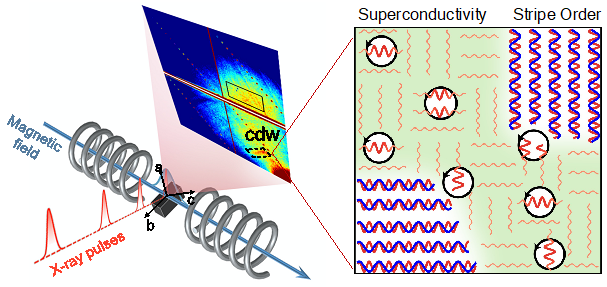Researchers at Stanford University have discovered that, contrary to popular belief, short-range charge density wave (CDW) correlations are compatible with superconductivity in cuprate superconductors, rather than necessarily being competitive. Their study has been published in Nature Communications.

Researchers combined high magnetic fields with X-ray scattering to reveal the connection between superconducting vortices (black circles), charge density waves (red wiggles), and spin density waves (blue wiggles) in a cuprate superconductor. Image Credit: Stanford University
The Science
In cuprates, which are materials containing copper, superconductivity interacts with two phenomena known as magnetic spin and electric charge density wave (CDW) order. These phenomena reflect different aspects of the electrons in the superconductor. While each electron has both spin and charge, in ordinary metals, spins generally cancel each other out and electrical charges are evenly distributed.
In contrast, high-temperature superconductors like cuprates experience significant electron-electron interactions that can lead to alternative states.
Recent research has explored materials where intense magnetic interactions cause some electron spins to arrange in stripes. This arrangement occurs when spin density waves (SDW) and CDWs synchronize, creating a stable "stripe state" where the wave peaks and troughs align. This stripe state enhances the stability of both SDW and CDW but competes with and disrupts the superconducting phase. Recent findings suggest that, contrary to previous beliefs, short-range CDW can actually coexist with superconductivity in cuprate materials rather than opposing it.
The Impact
The research investigated the interactions between short-range CDW and the long-range stripe patterns of CDW and SDW in relation to superconductivity. The findings revealed a complex scenario.
As anticipated, short-range CDW competes with the long-range stripe patterns, thereby suppressing superconductivity. However, it was also found that short-range CDW can coexist with and even enhance short-range superconductivity, which was an unexpected outcome.
Additionally, the study identified that short-range charge order could facilitate the formation and movement of vortices within the superconducting phase. This suggests that manipulating or increasing short-range charge order could stabilize superconductivity at higher temperatures and magnetic fields. These results offer valuable insights into creating a unified quantum framework for understanding superconductivity in cuprates.
Summary
Since the discovery of spin-charge stripe order in high-temperature cuprate superconductors, researchers have struggled to fully understand the interplay between spin and charge density wave orders and superconductivity. Recent findings indicate that short-range CDW correlations can actually coexist with superconductivity in these materials, contrary to the traditional belief that they are necessarily in competition. This research utilized X-ray measurements in a previously unexplored high magnetic field range on the cuprate La1.885Sr0.115CuO4.
The study revealed that CDW order comprises two distinct components, each with unique dependencies on magnetic field and temperature. The sample naturally divides into regions with superconductivity and regions with spin-charge stripe order, shedding light on how long-range spin order can coexist with bulk superconductivity.
Notably, at low magnetic fields, a static vortex state is present, but this state transitions to a vortex liquid state at higher fields (12 to 24 Tesla). In these high fields, the long-range superconducting phase is disrupted by field-induced mobile vortices. Interestingly, a significant increase in CDW intensity occurs at the vortex melting field, which is much lower than the upper critical field where superconductivity is completely suppressed.
These findings support the phase-disordering scenario for the superconducting transition and suggest a need for a unified quantum framework to describe the interplay between density waves and superconductivity in cuprate superconductors.
Journal Reference:
Lee, Y. S., et al. (2024) Enhanced charge density wave with mobile superconducting vortices in La1.885Sr0.115CuO4. Nature Communications. doi.org/10.1038/s41467-023-36203-x